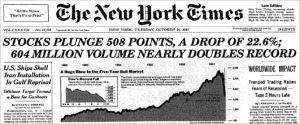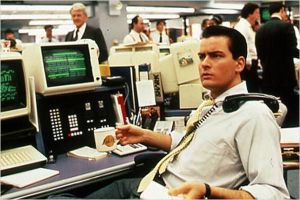We’ve been looking at the financial crisis of 2008 and seen how it impacted several facets of the economy, including the stock market. It made me want to take a look back at the market crash of 1987, known as “Black Monday,” which is the greatest single day collapse in market history.
On the morning of October 19th, 1987, the downturn initially started in Asia before sweeping to western markets. The Dow Jones, a leading index that measures 30 large American public companies, fell 508 points — nearly 23 percent in one day. This accounted for about $500 billion in losses. Every index was crushed, though, with the S&P 500 also diminishing by about 20 percent on the day. Chaos ensued. Nervous investors tried contacting their brokers to take their money out of the market, but many were unable to get through because of the high influx of calls.
The crash was extraordinarily improbable. Professor Henry T.C. Hu of the University of Texas calculated it was a “25 standard deviation event,” which meant “if the stock market never took a holiday from the day the earth was formed, such a decline was still unlikely.”
What made the misery all the more glaring was the run Wall Street had been on. The Dow had recently peaked in August of ’87 at 2722 points, which was an increase of more than 40 percent on the year. More confusing was the lack of a news event — like the subprime mortgages in 2008 — that would seem to trigger such a drastic fall. The week prior, the market had seen a correction that was sharp, with the Dow dropping more than 3 percent on two different days, but it was relatively inconsequential compared to what happened on the 19th.
Many analysts pointed to the rise in computer trading as exacerbating the problem. Program trading was relatively new at the time, and algorithms that calculated when to sell securities were triggered by the decline in share prices — which lead to a bigger crash. Today, virtually every trade is made electronically, but in the video below you can see two analysts who were less than thrilled with the technological advances the market had seen.
Class favorite Michael Lewis, who was working for Solomon Brothers back then, talked about how selling futures contributed to the hysteria.
The damage was so severe that the idea of closing the market for a day or two to “cool off” was even floated. Thankfully that didn’t happen, and the Federal Reserve pumped money into financial institutions and urged lenders to continue as if everything was normal (this sounds familiar from class). The Fed wanted to maintain liquidity and buoy investor confidence, and to a large extent this worked. The markets recovered slightly over the last two months, and closed slightly up for the year.
Still, the aftershock was felt for some time, with Wall Street not recovering to its 1987 marks until 1989. In an effort to curb a high volume of panic trades in the future, circuit breakers were put in place to pause trading and give investors time to process information before trading. Now, the New York Stock Exchange stops if the Dow falls 350 points from the previous day, or 200 points in one hour.



Leave a Reply
You must be logged in to post a comment.